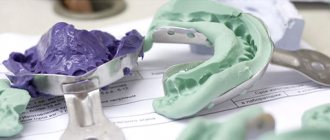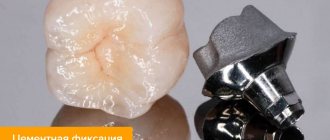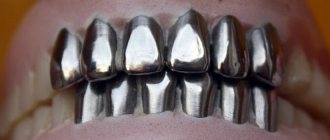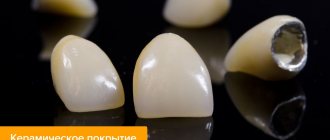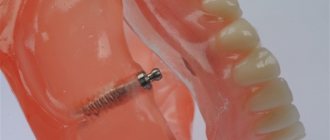What is this?
A bridge is a structure that consists of an artificial tooth (several) located between two crowns.
Crowns perform an important missing function and are placed on abutment teeth adjacent to the missing tooth. Such bridges are fixed using crowns, special glue and inlays, sleeves with pins. Several technologies are used in this complex process. As the name suggests, metal sleeves are used for manufacturing, from which single crowns are created; at the next stage, when soldered, they become a single whole structure.
The use of bridges is prescribed to replace missing natural teeth with artificial ones. It is used in the absence of one or several teeth in a row in a row.
Production technology
The production of soldered bridge structures is a labor-intensive and complex process that consists of several clinical and laboratory procedures.
Therefore, to undergo this type of prosthetics, the patient needs to visit the clinic several times.
Taking impressions
Before taking impressions, a set of primary measures is carried out, the purpose of which is to ensure the functionality of the dentofacial apparatus and its future health.
It includes a comprehensive examination and therapy of the patient’s oral cavity in identifying diseases.
The following actions of the dentist are aimed at directly preparing the teeth for prosthetics. If there are indications, the supporting units are necessarily cured, and if necessary, the nerves are also removed .
After preparing the oral cavity, the supporting teeth are prepared (grinded). This manipulation provides conditions for reliable fixation of the crowns, and consists in removing a certain layer of dentin from the surfaces of these elements.
The preparation must take place under local anesthesia with simultaneous cooling of the treated area. The size of the removed tissue layer is always equal to the thickness of the walls of the artificial crown, which is 0.3 mm.
This is interesting: How long after tooth extraction can you get dentures?
During the process, the doctor makes sure that the walls undergoing the procedure are parallel.
At the end of all actions, an impression is taken. For this, a standard impression tray and alginate mass are used. Instead of alginate, you can use dental plaster, but due to the labor-intensive nature of the work, it is used in isolated cases.
Important: to improve the retention of the material, it is proposed to treat the edges of the impression tray with adhesive.
After the impression is removed from the oral cavity, it is checked and disinfected. If the patient develops sensitivity and mild pain on the prepared units, the exposed dentin is treated with a desensitizer.
While a permanent prosthesis is being manufactured, the doctor may recommend a temporary one, which will allow the jaws and tissues to get used to the changes. The temporary structure will also protect the treated surfaces from unwanted infection.
In addition, to prevent the occurrence of inflammation in periodontal tissues, regenerative and anti-inflammatory therapy is prescribed.
Model making
In the laboratory, the technician begins his work by assessing the impression obtained. If the quality of the taken copy allows us to proceed to further production stages, he creates plaster models of the jaw.
Finished products are installed in the central ratio position. It is important to note that the intercuspal contact position of the teeth is individual for each patient.
Central occlusion is determined using special wax samples.
After determining the occlusion and central contact using plaster, the model is fixed in a special device, which was created to test the operation of artificial dental structures.
In dentistry, such a device is called an occluder. With its help, the technician can completely recreate the anatomical shape of the teeth and simulate the movements of the jaws in the open and closed position of the mouth.
Modeling the prosthesis body
After the gypsum mass has completely hardened, the model is rid of excess material that fixed it in the optimal position. Only the jaw model remains on the device.
Next, using wax, the stump of the prepared supporting elements is modeled, bringing its shape to the most natural appearance. The models remain fixed.
At the next laboratory stage, a technician cuts off the plaster with a special knife, making stamps.
Copies of cut dies are cast from metal alloys with a low melting point, which serve as the basis for stamping crowns that act as supports.
The finished products are transferred from the laboratory to the doctor for fitting in the patient’s oral cavity.
A crown intended for fixation on supporting units must meet a number of requirements, namely:
- ideally fit the natural shape of the bone organs;
- have a pronounced spherical surface that will protect the gums from food particles;
- the depth of immersion of the product under the gingival margin should be no more than 0.3 mm;
- overbite after installation should be excluded;
- ensure tight contact with the tooth surface and the area of the tooth neck;
- recreate the anatomical contact points of adjacent teeth.
If the crowns fully comply with the stated requirements and the doctor is satisfied with the design parameters, then he immediately makes impressions of them, which will serve as a model for modeling the body of the prosthesis.
Using the finished model, metal elements are cast from wax, which will subsequently replace the lost teeth. The crowns and impressions are again sent to the technician, who, following all the technical rules, will make the body of the prosthesis from wax.
Let's look at the steps of this procedure:
- the model is treated with water to prevent wax from sticking to it;
- the space between the supporting elements is covered with a wax roller, the volume and height of which exceeds the parameters of future new elements;
- The models of the upper and mobile jaws are fixed in the position of maximum intertubercular closure of the teeth;
- of the antagonist teeth is imprinted
- markings are placed on the roller , determining the number of intermediate teeth that form the body of the prosthesis;
- modeling of the chewing and vestibular surfaces of the restored elements is carried out.
The main stage of manufacturing the body of the structure is the formation of a prosthetic bed, which faces the gum tissue.
In order to avoid injuries to the surface of the tongue during the operation of the structure, the technician smoothes the transitions between the teeth on the oral side. Rounded bumps form on the chewing elements.
Casting
At the next stage, the wax model is redirected to the foundry. There, a metal product is cast on the basis of a wax sample.
Process algorithm:
- pins are installed in the wax product;
- a system of channels is created through which the molten metal will enter the casting mold;
- removing the wax composition from the model;
- creation of a casting tank;
- processing the wax composition with a facing layer;
- drying the coating;
- installation of a special metal form with a ward cone and a special additional element on the vibrator;
- pouring material for formation;
- release of the dental cuvette from the ward cone;
- removal of pins;
- wax melting;
- heat treatment of the mold;
- metal pouring;
- freeing the product from molding compounds;
- mechanical processing of the finished prosthesis body.
Soldering parts
After returning the finished pendant block from the foundry laboratory, it must somehow be connected to the stamped caps. This can be done:
- On a plaster model.
- Without using a model.
If the first method is practiced, the hanging block is glued to the supporting elements with wax. The structure is plastered into a ditch. In this case, the chewing surface should not be immersed in the refractory mixture.
When using the second method, the stamped caps are freed from the wax that fills them. To do this, the structure is heated over a burner flame.
The model must also be cleaned of wax. Surfaces that will be soldered are degreased and scale is removed. The bridge elements are installed on the model and fixed together with sticky wax.
Making sure that the adhesion is not broken, remove the prosthesis from the model. Next, plaster is applied in a refractory mass.
There is another modern soldering method using electric spot welding. It speeds up the technician’s work because... eliminates the plastering stage.
This is interesting: Popular models of containers for dentures: are they necessary?
The solder must have the following characteristics:
- The melting point is 50 - 100 °C lower than that of the base metal.
- Fluidity, to ensure high-quality fluxing.
- Diffuse to easily penetrate the structure of the base metal.
- Resistant to alkaline and acidic agents.
- Color that matches the base metal.
- Anti-corrosion.
- Physico-chemical properties close to the base metal.
- No shells or bubbles.
Finishing
After all production work has been carried out, the prosthesis is washed under cold water and the remains of auxiliary materials used during the formation of the entire structure are removed from its surface. Next, the product is bleached in a solution of hydrogen chloride.
Final finishing involves the use of a filing tool, artificial silicon carbide stones, and dental grinding discs.
With these devices, the specialist removes excess solder, smoothes out irregularities, processes the joints of elements and the occlusal surface of the crowns.
At the next stage of finishing, work is carried out aimed at polishing all components of the structure.
The final process is polishing. It is carried out using a special paste based on chromium oxide. After this manipulation has been performed well, the prosthesis is ready for installation.
Watch the video to see how bridges are installed.
Advantages and disadvantages:
+ small wall thickness, and this, first of all, indicates that at the preparatory stage it will be necessary to clean a small amount of dental tissue. Accordingly, the cost, based on this, will be low.
— the main disadvantage is the lack of precision in the fit of the crowns to the teeth, due to the manufacturing features. As a result, caries develops underneath them, which subsequently leads to complete destruction. It is not uncommon for a bridge to injure the gums, leading to chronic inflammation of the gums. In the future, inflammation can lead to periodontal disease and tooth loss.
- not only a plus, but also a minus is the small thickness of the walls. They quickly lose their function due to chewing loads, wear out and break.
— the solder of the product contains metals (copper, zinc, cadmium, bismuth), which, in turn, cause adverse reactions in the body: irritation of the oral cavity, affecting the oral mucosa, provokes a disease of the digestive system and severe discomfort.
- due to the influence of saliva, metals oxidize, and an unpleasant taste appears in the person’s mouth.
— the strength of soldered products is much lower than that of solid cast structures.
— crowns have poor relief of the chewing surface due to their unevenness. These deficiencies interfere with the grinding of food and lead to problems with the mandibular joints.
Types of structures:
- Metal-ceramic.
- Adhesive.
- Solid cast.
- Stamped.
- Ceramic.
- Bridge-like structure with submerged supports.
Care
Teeth brushing should be done efficiently and daily. After each meal, hygienic treatment of the oral cavity with mouth rinse is necessary. To brush your teeth, it is more convenient to use a special brush made in the shape of a triangle with a recess.
For better oral care, home irrigators are used. Since prosthetics are carried out for a long time, the purchase of this product is justified. It allows you to avoid complications of wearing orthodontic structures (inflammatory periodontal diseases, secondary caries).
Solid bridge
The product is made using special casting. The advantage is that the crown itself fits firmly to the ground tooth, so the places in contact with the gum and possible gaps are not clogged with food debris.
This type completely eliminates destruction. There are also disadvantages to this design. This is primarily a great sensitivity to hot. A person experiences discomfort when eating hot food.
total cost
The price of a soldered prosthesis compares favorably with all other options for analog designs. The estimated cost of one artificial crown is 800 rubles.
Considering that to install a prosthesis from just one crown, it is necessary to make 2 more to attach it to the supporting teeth, the cost of the product triples.
The final payment for prosthetics consists of the following factors:
- the number of dental elements requiring restoration;
- number of additional treatment and preparatory procedures;
- qualification of a dental prosthetist;
- clinic pricing policy.
Bridge stamped and soldered
This method is considered the oldest and has been used since Soviet times. Made from a thin-walled sleeve shell. This occurs during the process of compressing a plaster copy of the tooth. At the joints they are soldered, which ensures a continuous connecting structure.
Disadvantages can be considered:
- the impossibility of creating an exact shape due to a loose fit,
- using this type of prosthetics, there is a high probability that caries will form in the future and this will lead to tooth loss,
- the walls turn out to be thin and, as a result, quickly wear off, which leads to destruction and breakage.
- Patients experience bleeding from the gums and an unpleasant metallic taste due to metal oxidation.
Where to go
Dentistry Beskudnikovo is located in the district of Moscow of the same name, within walking distance from the Verkhniye Likhobory, Seligerskaya, and Okruzhnaya metro stations. We have at our disposal high-precision digital equipment, modern materials and the invaluable experience of our employees, which allows us to work in the field of the latest dental technologies at the level of world standards. And all this surrounded by a friendly atmosphere of calm and comfort.
To make an appointment with us, just call the numbers listed on the website or leave your contacts in the online form, and then we will call you ourselves.
Bridged Maryland
In prosthetics, this design is used with submerged supports. It differs from the classic type in that not complete, but partial turning is carried out in the places selected for supports; small cavities are made there for immersing the legs of the prosthesis into them. Subsequently, the cavities are closed with fillings.
Advantages and disadvantages:
- The main positive quality of this type is considered to be preservation of the pulp and minor removal of enamel. Therefore, gum disease is excluded in this case.
- This type of prosthetics is used only if the supporting teeth are healthy.
- The prosthesis is considered ideal only for temporary restoration.
- The product itself is not durable, since the legs cannot withstand heavy loads and can become cemented.
- In modern practice, the Maryland method is used only in the front rows.
What material is used?
The stamped-soldered bridge product is made from metal alloys of noble (palladium, silver, gold) and base metals (chrome, stainless steel, nickel). For cladding, elements of acrylic plastics are used.
Indications for manufacture and use:
- various damages,
- developmental anomalies of position and shape,
- clasp support arms are incorrectly positioned,
- special support for bridges,
- treatment of tooth abrasion,
- pathological occlusions,
- dysfunction of the masticatory muscles,
- incorrect bite development,
- not large sizes of teeth. Subsequently, the cavities are closed with fillings.
Contraindications for use are:
- Defects that disrupt the orientation function of periodontal fibers.
- Defects that are associated with high mobility in the presence of a small clinical crown with a small reserve of periodontal strength. This happens with short roots.
- Diseases associated with viral infection. These are chronic diseases, such as tuberculosis, as well as a period of chronic exacerbations.
The process of preparing the dentition
Preparation begins with dental treatment and, if necessary, removal of nerves, including in the supporting teeth planned for installation. In case of severe destruction, special tabs are used to help withstand severe loads. If the indications are favorable, then the nerves are not removed.
Installation
The process of installing stamped-soldered prostheses goes through several clinical and laboratory stages.
First stage
The tooth is prepared under local anesthesia. After the procedure, an impression is taken from the remaining bone formations. This occurs on the same day if there is no periodontal damage or at the next appointment if there is any.
The casts are then inspected for damage. If they are not there, they are disinfected and removed. If the prepared teeth cause discomfort to the patient, they are treated with a desensitizer.
The tissues of the oral cavity are treated with anti-inflammatory and regenerating solutions of tincture of oak bark, sage, and chamomile. This will help heal periodontal injuries.
The crowns of the future prosthesis are made using the stamping method.
Second phase
The doctor evaluates the quality of the crowns, especially the density of the marginal fit (in the cervical area), the force of pressure on the periodontium, the correspondence of the contours of the supporting tip with the corresponding part of the tooth, the degree of immersion in the groove (the maximum permissible level is from 0.3 to 0.5 mm), contacts with antagonists (occlusal and proximal).
If parts of the prosthesis do not meet the requirements, they are corrected. During the same visit, the color of the cladding and facets, if any, are determined. With the crowns in place, an impression is taken from the patient. It and parts of the future prosthesis are disinfected and transferred to dental technicians in the laboratory.
Then the remaining part of the prosthesis is manufactured by soldering.
Third stage
The finished orthodontic device is applied to the patient. The physician again examines the structure for occlusal and proximal contacts with antagonists, as well as the flushing zone located under the intermediate part.
Materials for dental prosthetics
In orthopedic dentistry, many different materials are used to make removable and non-removable structures.
If inconsistencies are identified, the deficiencies are corrected. The correct manufacturing and degree of polishing of all structural parts is monitored.
If there are no deficiencies, the prosthesis is fixed in the oral cavity with cement. The procedure is carried out with the jaws closed as much as possible. It is especially important at this stage to ensure that the remaining adhesive materials are thoroughly removed from under the denture and between the teeth.
After completing all stages, the doctor explains to the patient the rules for caring for the orthodontic apparatus.

